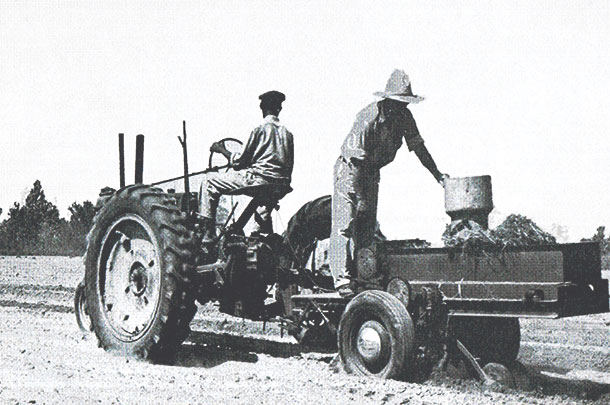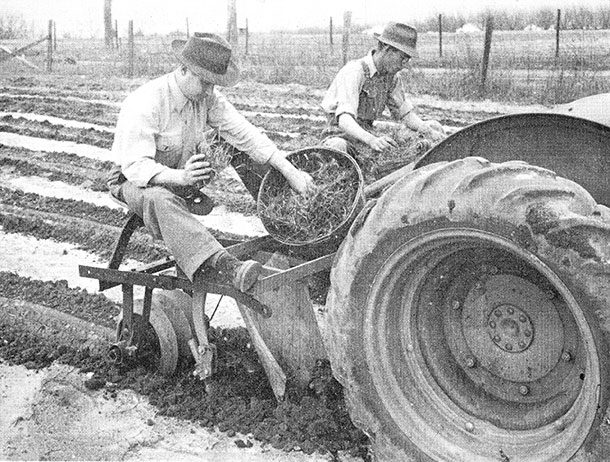So any grass was a threat and not long for this world. Grass wasn’t even allowed in the yard. Yards were kept bare, and the soil was regularly swept clean with a broom made of branches. This makes it all that much more wondrous bermudagrass, the bane of every cotton farmer’s existence and worst of the despised grasses, is now grown on about 15 million acres in the southeastern U.S. and as many as 30 million acres in total.
It is the ultimate story of making lemons into lemonade, and one of the main characters in that story was Coastal bermudagrass. Coastal was the first hybrid bermudagrass to be commercialized. It was bred and officially released in 1943 by Glenn Burton, a USDA-ARS geneticist based at the Coastal Plain Experiment Station in Tifton, Georgia.
This article is written as a tip of the cap to Coastal on its 75th year and to the dedicated breeders, researchers and extension specialists who have revolutionized grass production in the South.
In the beginning
Common bermudagrass was reportedly introduced into the U.S. (probably from either India or Africa) in the early 1750s in Savannah by Georgia’s second royal governor, Henry Ellis. Subsequently, it had naturally spread to many areas of the southern U.S. by the late 19th century.
Though it was used for forage in pastures and hayfields during this period, it was largely regarded as a noxious weed – a reputation it still holds in some regions.
James L. “Cowboy” Stevens was the first USDA-ARS forage agronomist in 1928 at the Coastal Plain Experiment Station in Tifton. He established an initial bermudagrass nursery there in 1929 and included a local bermudagrass ecotype found in a cotton field near Tifton that he named ‘Tift.’
That initial introduction nursery formed the basis of forage improvement for bermudagrass. Stevens’ explorations and collection trips brought many valuable bermudagrass plant introductions from various parts of the world such as southern Africa and South America.
Breeding bermudagrass for forage production
In 1936, Glenn Burton was hired as a plant breeder at the ARS facility in Tifton. At the time, his attempts to make an improved, or more vigorous, bermudagrass were viewed as radical, to say the least. But Burton saw the potential it had as a forage crop. In 1937, Burton collected seed from Tift bermudagrass and two vigorous hay-type bermudagrasses from South Africa growing adjacent to each other in the introduction nursery.
Hybrid seed was germinated in the greenhouse, and 5,000 spaced plants were established in 1938. Of the 147 plants selected from the 5,000, selection number 35 was destined to become Coastal bermudagrass. Silas Starr, then director of the Coastal Plain Experiment Station, felt number 35 should be named ‘Coastal’ to recognize the experiment station where the hybrid was made and tested.
Coastal was very vigorous but set only a few seeds. In the testing process, it became evident it may be possible to vegetatively establish bermudagrass commercially. In 1942, one of Burton’s USDA-ARS bosses from Washington, D.C. visited Tifton and saw common bermudagrass full of seedheads growing next to Coastal with no seedheads.
Burton’s boss wanted to know how he planned to propagate Coastal. Burton said, “vegetatively.” The USDA boss said, “Whoever heard of planting pastures vegetatively?”
Burton was undeterred and developed a wooden stick with a metal plate like a putty knife on one end that was first used to push sprigs (stolons and rhizomes) into the soil like planting sweet potato vines. Later, James Stephens, an agricultural engineer with the University of Georgia at the Coastal Plain Experiment Station, developed a two-row planter.
 As more Coastal bermudagrass was planted, farmers became innovative and developed their own methods and machines.
As more Coastal bermudagrass was planted, farmers became innovative and developed their own methods and machines.
An industry is born
Around 1940, Mr. L.L. Patten, a cattleman, legislator and owner-operator of Patten Seed Company, visited the research station and saw Coastal growing in plots. Patten wanted some of the grass, and Starr convinced Burton he should give a few Coastal bermudagrass sprigs to him even though the grass was not officially released.
Patten took the grass to his farm in Lakeland, Georgia, where he increased it to a 16-acre field. This demonstrated the practicality of vegetative propagation and gave birth to an industry of selling sprigs. “Word-of-mouth” was apparently all it needed. Bill Roquemore, son-in-law of L.L. Patten, later recounted, “Ranchers would come to Tifton with a gunnysack and a pitchfork to dig a few sprigs.”
Bermudagrass spread across the South
Patten became the first certified grower of Coastal, and interest was so high that, by 1950, Patten had built a brisk family business selling sprigs to cattlemen from the Carolinas to Texas and Oklahoma. Roquemore said there were times when as many as 65 trucks from a half-dozen states waited to be loaded with 25 to 50 bushels of sprigs.
In the early 1950s, Roquemore felt there was money to be made delivering sprigs to farmers, so he started taking orders. Every five or six days, he hauled 1,000 bushels west to Texas, Oklahoma, Arkansas and Louisiana. To keep the sprigs from getting hot, Roquemore put 2 tons of ice on top of the load before heading west.

The ice would melt during the trip and keep the grass cool. By 1958, many counties from east Texas to Virginia had two or three farmers selling Coastal sprigs.
Improvements in forage yield and quality
Coastal helped transform forage production for those producers who planted it. It produced twice the forage yield common bermudagrass produced. In fact, this cultivar has been a major factor in keeping beef and milk production profitable in the southern U.S., but it is far from the only one.
 Building on the success of Coastal, plant breeders began working on developing new and improved forage hybrids. Public and private forage bermudagrass breeding programs in Oklahoma, Florida and Texas, among others, have since contributed over 30 varieties registered as official releases in the U.S. These have also made an impact internationally. These varieties are now collectively planted on more acres in Central and South America than they are in the U.S.
Building on the success of Coastal, plant breeders began working on developing new and improved forage hybrids. Public and private forage bermudagrass breeding programs in Oklahoma, Florida and Texas, among others, have since contributed over 30 varieties registered as official releases in the U.S. These have also made an impact internationally. These varieties are now collectively planted on more acres in Central and South America than they are in the U.S.
Perspective
The story behind the development of bermudagrass is an interesting tale to many of us in the forage industry in the southern U.S. After all, who doesn’t like to root for the underdog? Plus, it is also a story of how, when given the resources, a publicly funded research team can develop innovations, partner with private enterprises and revolutionize an industry.
Ultimately, it is a story about courage, vision, leadership and an unabated desire to make agricultural production more productive and efficient. ![]()
PHOTO 1: University of Georgia agricultural engineer James Stephens developed an early two-row sprig planter at the Coastal Plain Experiment Station.
PHOTO 2: This is a sprigging stick designed to push bermudagrass sprigs into the ground.
PHOTO 3: This is an early commercial sprigger.
PHOTO 4: Sprigs are forked into a truck for transport. Photos provided by Dennis Hancock.

-
Dennis Hancock
- Professor and Forage Extension Agronomist
- University of Georgia
- Email Dennis Hancock









